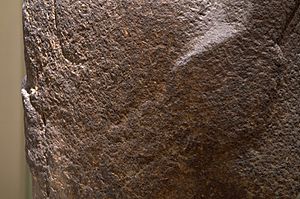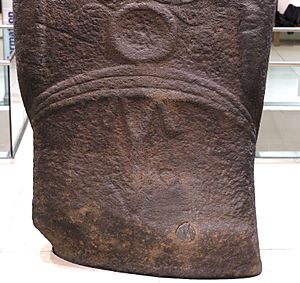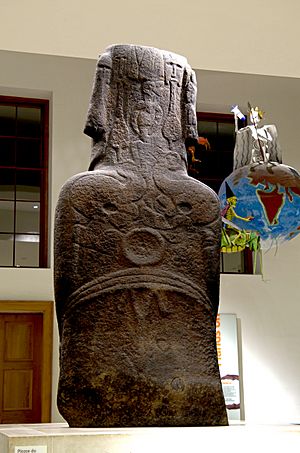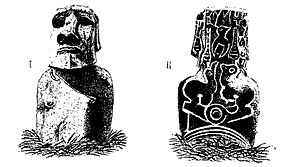Hoa Hakananai'a facts for kids
Quick facts for kids Easter Island Statue |
|
|---|---|
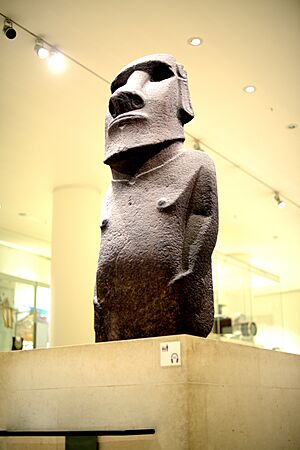
Hoa Hakananai'a in the Wellcome Gallery in the British Museum
|
|
| Material | Flow lava |
| Size | Height: 2.42 metres (7.9 ft) |
| Created | c. 1000-1600 AD |
| Present location | British Museum, London, Gallery 24 |
| Registration | 1869,1005.1 |
Hoa Hakananai'a is a famous stone statue, called a moai, from Easter Island. It was taken from the island in 1868 by a British ship. Today, you can see it at the British Museum in London.
Many people think it's a "masterpiece" and one of the best examples of Easter Island art. Even though it's not the biggest moai, it looks like other statues from the island. What makes it special are the unique carvings on its back. These carvings are linked to the island's old birdman cult.
Contents
What Does the Name Mean?
When the statue was taken, islanders called it Hoa Hakananai'a. The British crew wrote down the name as 'Hoa-haka-nana-ia'.
This name has many meanings in the Rapa Nui language. Some people say it means 'breaking wave' or 'surfing fellow'. Others think it means 'lost friend' or 'hidden friend'.
Where Was It Found?
In 1868, Hoa Hakananai'a was standing upright in a special ceremonial house. This house was in the Orongo village on Easter Island. The statue faced a volcanic crater called Rano Kau, with its back to the sea.
It might have been made for this exact spot. Or, it could have been moved there after being made somewhere else.
Experts believe the statue was carved between 1000 and 1200 AD. Moai statues were generally made from about 1000 AD. Most were created between 1300 and 1500 AD. Islanders stopped making them around 1600 AD and began toppling them over.
What Does It Look Like?
Like other Easter Island moai, Hoa Hakananai'a has a strong brow and a blocky face. It has a noticeable nose and a chin that sticks out. Its thin arms go down its sides, and its hands reach towards its stomach.
It has a raised Y-shape on its chin. Its eyes are hollowed out, like other statues placed on ceremonial ahu platforms. It also has long, rectangular ears. A line around its neck might show its clavicles (collarbones).
Most statues on Easter Island are made from reddish rock. But Hoa Hakananai'a is made from a dark grey-brown lava. It stands about 2.42 metres (7.9 feet) (8 feet) tall. It is 96 cm (3.15 ft) (3 feet) wide and weighs 4.2 tonnes.
The bottom of the statue is now hidden by a modern stand. It might have been flat or rough and pointy when it was first made.
Originally, the back of the statue was probably plain. It had a maro, which is like a belt, made of three raised lines and a circle. Below that was an M shape on a vertical line.
The top of its head is smooth and flat. It might have once held a pukao, which is a cylindrical stone "hat." A flat round stone found nearby could have been this hat.
Special Carvings
The back of the statue has many carvings. These were added later, after the statue was first made. They look like other rock carvings, called petroglyphs, found around the Orongo village.
On either side of the maro (belt) are two birdmen. These are human-like figures with beaked heads. They are thought to represent frigatebirds. Above them, in the center of the head, is a smaller bird. This bird is believed to be a sooty tern (manutara).
On each side of the sooty tern are ceremonial dance paddles (ao). These paddles were symbols of male power. There is another paddle on the left ear and four symbols on the right ear. Y-shaped lines also go down from the top of the head.
When Europeans first saw these carvings, they were painted red on a white background. The paint mostly washed off when the statue was moved to the ship.
People have different ideas about what these designs mean. The birdmen are often seen as Makemake. He was a fertility god and the main god of the birdman cult. This cult was recorded by early European visitors.
The birdman cult involved an annual competition. People would try to find the first egg laid by migrating sooty terns. This contest took place at Orongo. The winner became Makemake's representative for the next year. The last ceremony probably happened in 1866 or 1867.
New Discoveries
New studies have looked closely at the statue using special technology. They used Photogrammetry and Reflectance Transformation Imaging. These methods create very detailed digital images.
These studies helped to clarify many details. For example, the Y-shaped lines on the head are parts of older carvings that were partly removed. The small bird has a closed beak, not an open one as once thought. The left birdman's foot has five toes, not six.
Archaeologists who did this study also suggested a new way to understand the main carvings. They think the carvings show the birdman ceremony. They suggested the left birdman is male, the right is female, and the bird above them is their new baby bird. They also suggested the whole statue became Makemake, with its face painted white. Some experts found this idea interesting but disagreed with parts of it.
You can even see the digital models of the statue online. These models help people study the carvings and discuss their meanings.
Its Journey to the Museum
British sailors from the ship HMS Topaze found Hoa Hakananai'a in November 1868. When they first saw it, about half of the statue was buried in the ground. They dug it out and dragged it down to the ship on a sledge.
The statue was photographed in Valparaíso, Chile, before the ship sailed to England. The captain of the Topaze offered the statue to the British government.
HMS Topaze arrived in Plymouth, England, in August 1869. The British government offered the statue to Queen Victoria. She suggested it should go to the British Museum. It was placed on a stand and displayed outside the museum.
During World War II, it was moved inside for safety. It returned to the main British Museum building in 2000. Today, you can find it in the Wellcome Trust Gallery (Room 24).
The director of the British Museum, Neil MacGregor, chose Hoa Hakananai'a for his famous radio series, A History of the World in 100 Objects.
Should It Go Back Home?
The Rapa Nui people believe the moai was taken from their island without their permission. In 2018, the Governor of Easter Island, Laura Alarcón Rapu, asked the British Museum to return the statue.
The museum agreed to talk about lending the statue to the people of Easter Island. A museum expert visited Easter Island in 2019 to discuss this. A documentary film called Te Kuhane o te tupuna (The spirit of the ancestors) also talks about Hoa Hakananai'a. It suggests that the statue's spirit, or mana, needs to return to Easter Island for the island to be well again.
See also
 In Spanish: Hoa Hakananai'a para niños
In Spanish: Hoa Hakananai'a para niños
- Rapa Nui mythology
- Relocation of moai objects
- Tangata manu
- 2010 Easter Island moai referendum



